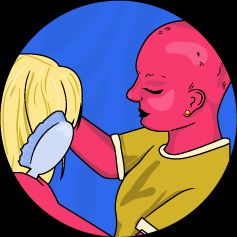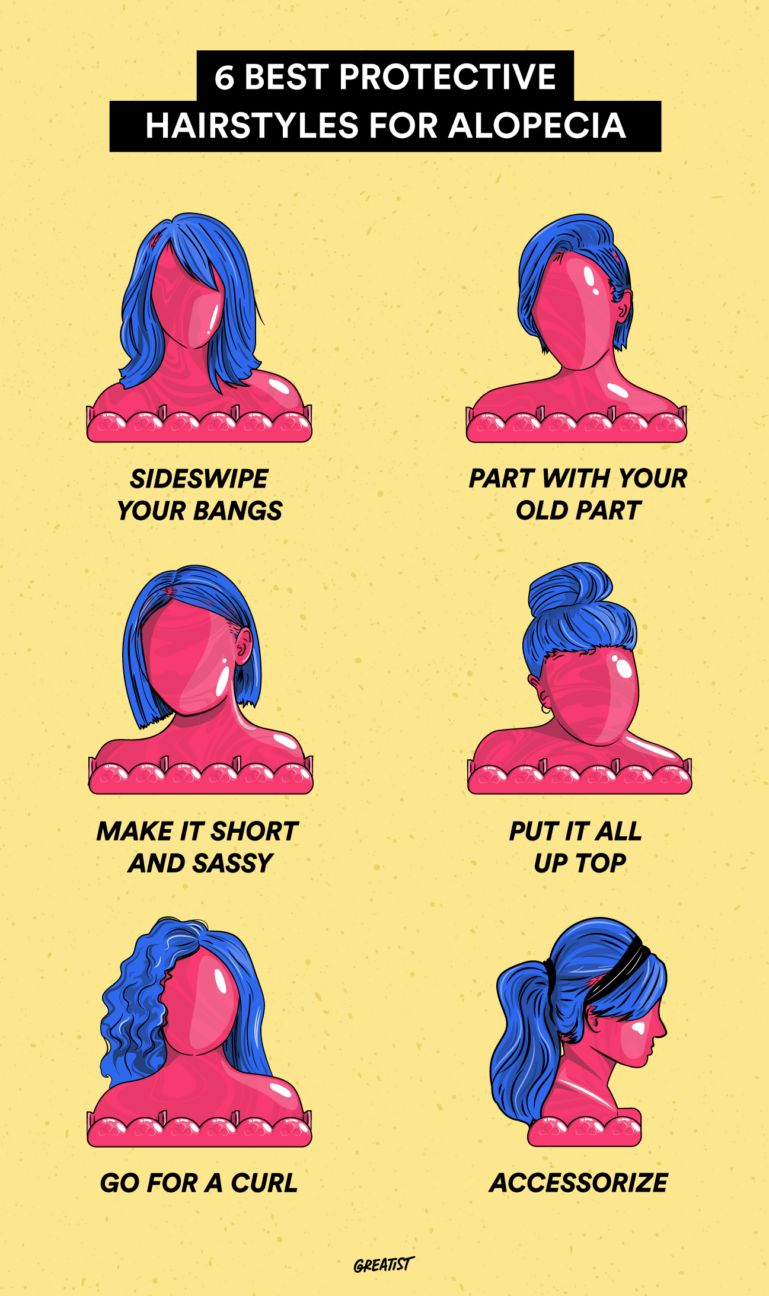If patches of hair loss are messing with your self-image, a different do could be the way to hide them — and protect the hair you still have.
Hair falls out for lots of different reasons — you’re getting older, you don’t eat enough nutrients, or you’re overdoing it on the heat styling.
Sometimes a condition like alopecia areata makes you lose your hair. If you think of your hair as an integral part of your identity, seeing missing patches when you look in the mirror can be distressing, to say the least.
There’s a chance your hair will eventually grow back on its own. If it doesn’t, or it’s growing at a snail’s pace, your dermatologist has treatments to bring it back faster.
In the meantime, a few clever styling tricks can masquerade those bald spots and potentially protect the rest of your hair. Once you (or your stylist) find the right one, no one will ever know what you’re missing.
Sideswept bangs are a good way to hide thinning along your hairline. And bonus — they’re totally trending right now.
For those not in the know, sideswept or side bangs are shorter pieces of hair in the front. Have your stylist cut them as short as you’d like. Then dry those bangs with a big round brush to create volume and sweep them off to one side of your face.
A top knot is the modern incarnation of that old-fashioned bun your grandma used to rock. Putting all your hair on top of patchy spots is a great way to hide hair loss on the top part of your head.
There are many ways to knot. One easy method is to pull your hair into a high ponytail, twist and wrap that ponytail around itself, and hold it all in place with bobby pins. Or skip the knot and just backcomb the hair underneath your ponytail to create more volume.
When you do that up-do, just remember to keep it loose. Tightly pulled buns, ponytails, and cornrows can accelerate hair loss. A loose topknot will also hide bald patches while giving you a messy chic aesthetic.
Cutting your hair short might seem like the last thing you’d want to do when you’re losing hair. In reality, the shorter your hair is, the fuller it will look.
One option is a Caesar cut. It’s just a super short haircut with bangs. The trick is that instead of combing your hair backward, you style it forward to cover any bald patches.
A bob is another way to disguise hair loss. Make it blunt (straight across), cut it into face-framing layers, or let it go curly. To get more volume from your bob, add mousse to the ends and then blow dry with a big roller brush.
Who said a part has to be straight down the middle? Mess with your part to hide areas of scalp that are lacking. Flip it to the side (trust us, this isn’t your uncle’s combover) or create a zig-zag pattern.
You might also try a super cute, deep side part. Start a little bit farther to the side than your usual part, using a comb to create the new part. Then flip your hair to the side that needs a little extra cover.
A head full of bouncy curls creates the illusion of a full head of hair. Using a diffuser when you dry your hair will give those curls more volume.
If you’re a little lacking in the curl department, get a perm. Or use a curling iron to create temporary curls. To avoid heat damage, plait your hair into braids and leave them in overnight. You’ll wake up to a pillow full of voluminous waves.
A twist-out is a good way to conceal if you’ve got natural hair.
To get this look, divide your hair into sections. To create a tighter pattern, create small sections. For a looser pattern, keep the sections bigger. Apply a layer of leave-in conditioner and curl-defining cream to your hair. Then divide each section in two and twist one half around the other.
The bonus with this look is that you don’t need to heat-style it, sparing your scalp from more damage.
If you’ve simply got more hair loss than a new hairstyle can hide or protect, add a head covering. Put on a headband for casual or day wear. Tie on a scarf that matches your outfit. Or pop on a hair topper for added fullness and glam.
Losing your hair from alopecia can be frustrating and upsetting. We get it. Your hair may grow back in time, either on its own or with a prescription med from your dermatologist. In the meantime, a few hairstyles can help conceal those patches of hair loss.
Restyling is only one part of alopecia hair care. Avoiding dyes and other harsh chemical-filled products, keeping it loose (no tight ponytails), and using a soft-bristled brush will help protect the hair you still have.


